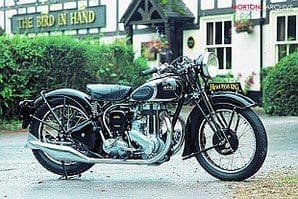
The owner and restorer of this Ariel, Mike Lymn, is a man who gets things done. Whether it be house building, gun remanufacturing, artwork restoration or bringing old motorcycles back to life, Mike relishes a challenge, and for his first restoration he didn’t pick a particularly easy project, one for which there were plenty of off the shelf parts available. But he did know exactly what he wanted to restore and so set out to find that machine – a 1930s Ariel, as his first motorcycle memories were of such a machine, owned by his father in the years just after World War II.
So, the search was on, and it turned up what we see before us – but in a very different state to what it’s in now. The Ariel had been bought previously for its number plate, which had been sold, and then the Ariel was subsequently sold on. As acquired by Mike, some restoration had been attempted – but not to a particularly good standard.
When Mike brought the Ariel home, his first task was to strip what had been assembled completely, and start again. Most of the major components were there, and though the frame had been powder coated, it wasn’t up to Mike’s standards, so it was repainted in the lustrous, deep black it now wears.
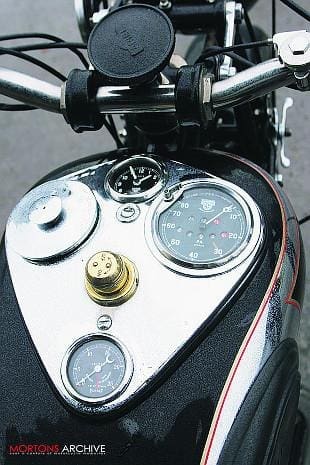 Friend John Seward cajoled Mike into getting the Ariel finished in time for the 1999 Gales Brewery Run, and it was completed the week before, with the project taking 1200 hours, or a year, in total. On its first public outing, the black-and-chrome beauty scooped second place in its class, a testament to Mike’s skill, patience and perseverance.
Friend John Seward cajoled Mike into getting the Ariel finished in time for the 1999 Gales Brewery Run, and it was completed the week before, with the project taking 1200 hours, or a year, in total. On its first public outing, the black-and-chrome beauty scooped second place in its class, a testament to Mike’s skill, patience and perseverance.
This particular model is a 1938 NG, fitted with a twin-port head but without the upswept pipes and the bright red finish of the more well-known Red Hunter. The NG also has a lower state of tune that the sportier NH (Red Hunter), but otherwise overall specification is quite similar. The engine, gearbox, frame and cycle parts are, for the most part, common to both models, with just detail items differing, which helps, a bit, with the spares.
The beauty of riding machines from the period of this Ariel, is to me, their low saddle height and subsequently low centre of gravity. The Ariel didn’t disappoint as I settled into the seat, and reached for the flat, ideally placed handlebars. Starting proved easy and reliable, a firm kick bringing the healthy-sounding motor into life.
Setting off, the 350cc engine seemed willing – clearly painstakingly and very well put together. The ‘briskness’ of machines from this era would surprise many used to 50s and 60s machinery I’m sure – as would the level of comfort afforded by suspension which amounts to no more than a sprung saddle at the rear and girder forks up front. Acceleration proved equal to that of many later machines, due in no small part to the lower weight of the machine – indeed, a 50s 350cc Ariel single features a broadly similar engine, but has to haul an extra 50lb or so.
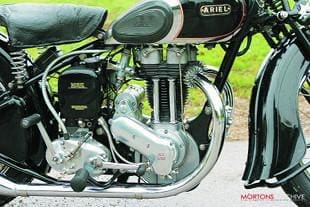 The gearbox worked well and smoothly, rewarding deliberate changes with easy selection, while the brakes were perfectly adequate, though the tricky conditions at the time of my ride – wet, greasy roads – meant that caution was the order of the day. Riding someone else’s pride and joy – which before our test had rarely, if ever, seen rain – meant that braking was a progressive, delicate affair. Not that the NH is overly cosseted, indeed Mike has done 8500 miles since the rebuild – he just chooses to ride the Ariel during the summer months.
The gearbox worked well and smoothly, rewarding deliberate changes with easy selection, while the brakes were perfectly adequate, though the tricky conditions at the time of my ride – wet, greasy roads – meant that caution was the order of the day. Riding someone else’s pride and joy – which before our test had rarely, if ever, seen rain – meant that braking was a progressive, delicate affair. Not that the NH is overly cosseted, indeed Mike has done 8500 miles since the rebuild – he just chooses to ride the Ariel during the summer months.
Despite the inclement conditions, I felt at home on the Ariel, safe and secure, and confident in its forgiving nature. It was a delightful machine to ride, with enough torque to maintain a high gear for longer than the rider would expect, for what is – in modern terms – a relatively small engine. Of course, back when the NG was built, a 350 was regarded as a ‘proper’ sized motorcycle; indeed, it was regarded as a middleweight.
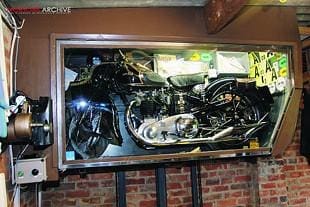 The 350cc class was the most popular of the era, offering a good compromise between ‘big bike’ performance and fuel economy, and most of the major makers offered at least one, or in many cases, including Ariel, different models of that capacity. The NG was aimed at the less sport-orientated rider (there was the Red Hunter for them) – more the discerning rider who favoured sober, subtle styling, but with obvious understated class, rather than brash-and-flash bright colours.
The 350cc class was the most popular of the era, offering a good compromise between ‘big bike’ performance and fuel economy, and most of the major makers offered at least one, or in many cases, including Ariel, different models of that capacity. The NG was aimed at the less sport-orientated rider (there was the Red Hunter for them) – more the discerning rider who favoured sober, subtle styling, but with obvious understated class, rather than brash-and-flash bright colours.
Mike had long wanted an Ariel, owing to the fact that as a child he remembers his father owning one – albeit an earlier model than that which now graces his garage.
“My father had an early 30s side valve Ariel with a sidecar. It had actually been owned by my uncle before WWII, and it was garaged during the war. After he’d come out of the services he went to collect it – to find that loads of bits had been stolen from it.
“My uncle didn’t fancy trying to source the missing parts, so he gave what remained to my father, who duly rebuilt it, as well as making a sidecar for it. I remember helping with the sidecar construction – though ‘hindering’ is probably more accurate.”
Mike’s memory of the Ariel inspired him to become a motorcyclist himself, with his childhood enlivened with a variety of field bikes, shared with friends in the locality.
“We had loads of bikes and youngsters and I’m sorry to stay, smashed up loads too. I particularly remember a 1930-something Harley-Davidson V-twin, which we bought for £5, dragged out of a shed in Lovedean and rode round and round fields. We had all sorts of bikes, mainly BSAs and Triumphs, though, never a Norton I remember. Each one was bought for two or three quid then ridden into the ground.
“After that, I graduated to the road, but gave up motorcycling when I met my wife and switched to a car. I still had my licence, though, and John Seward talked me back into bikes.”
When deciding to rea waken his motorcycling passion, Mike wanted an Ariel as a project, because of those early memories. So, he put a wanted advert in a motorcycle magazine and turned up with this one, though another reply to his wanted ad also yielded a contact that has proved helpful.
waken his motorcycling passion, Mike wanted an Ariel as a project, because of those early memories. So, he put a wanted advert in a motorcycle magazine and turned up with this one, though another reply to his wanted ad also yielded a contact that has proved helpful.
“Ray Butcher from Wales replied to my wanted ad and has been able to supply me with many bits and pieces, some which were damaged, but which I saw as a challenge to restore. For example, Ray was able to provide the rear number plate. It was very squashed and misshapen, but I managed to save it, with plenty of hours lavished on its reconstruction. It was a similar story with the chainguard, which took quite some work.”
Mike’s efforts and endeavours have rewarded him with an extremely attractive and eminently usable machine, which is pressed into service on a number of local runs and rallies. Incidentally, when it’s not in use it lives in an elevated case in Mike’s garage – built, of course, by the man himself. Sealed within, and surrounded by various awards and plaques picked up at shows and events, the Ariel looks look a static museum display, but within a couple of minutes, Mike has dropped a lever, the case descends gracefully to the ground, a couple of fasteners are undone and Ariel is liberated, and ready for the road. The case is a work of art, being the perfect place to keep the Ariel’s pristine finish up to its immaculate standard. It’s a testament to Mike’s original restoration, and the care he has kept in maintaining it to that standard in the meantime, that the Ariel still looks like a fresh restoration.
‘The NG De Luxe model appeared in the Ariel range for the 1936 season, with a retail price of £53-10s, compared to the 350cc Red Hunter’s price tag of £57-10s’
The NG De Luxe model appeared in the Ariel range for the 1936 season, with a retail price of £53-10s, compared to the 350cc Red Hunter’s price tag of £57-10s. It was somewhat confusingly catalogued only as a De Luxe model, which meant that it came with a four-speed gearbox and enclosed primary oil-bath chaincase, which were also common to the Red Hunter. Mike’s example has valanced mudguards fitted, which were an optional extra, costing 7s-6d each.
 The earlier ‘cooking’ model in the Ariel range, running alongside the Red Hunter, was the NF, which was discontinued on the NG’s arrival.
The earlier ‘cooking’ model in the Ariel range, running alongside the Red Hunter, was the NF, which was discontinued on the NG’s arrival.
In the early 30s, despite – or because of – an extensive range, Ariel ran into serious financial problems, owing to the tough economic conditions of the period. Their efforts during 1931 led to the Selley Oak concern being awarded the prestigious Maudes Trophy, but by 1932 the financial problems were becoming serious. Jack Sangster, whose family had been involved with Ariel for many years, was determined to save the company, and set about reducing costs by slimming down the workforce, the factory and the range.
Chief designer Val Page departed, moving to Triumph, while one who gained from the reshuffle was young designer Edward Turner. Already responsible for Ariel’s most glamorous model, the unique Square Four, Turner set-to on the range, doing away with many of the different engine/cycle-part combinations, making more parts common across the models and introducing what in modern parlance would be called a ‘modular’ concept.
Soon gone were all manner of ‘sloper’ configuration engines – of both side- and overhead-valve arrangement – and frame styles, as the range settled into the format it was to continue in for the decade. Interestingly, Turner’s expensive Square Four survived the cull, though that model apart, all the others were singles; all, though, including the ‘Squariel’ shared a common design of cycle parts. Indeed, all the dimensions given for the 1938 range – wheelbase, length, saddle height etc – were common for all models.
From Turner’s pen came some exquisite styling touches, as Ariel began to gain a firmer financial footing, largely aided by a fine and well-deserved reputation for value-for-money performance coupled with above-average build quality.
Speedmen the length and breadth and the country – and, indeed, overseas too – appreciated the opportunity afforded to them by, especially, the Red Hunter models. The performance from the 500cc versions was not far short of the glamorous high-speed offerings from the likes of Norton. A Bracebridge Street-built 500cc International Model 30 would have cost £90 in 1936 (the less ‘racy’ CS1 was still £80), while a 500cc Red Hunter was on sale for £65-10s – a whopping £24-10s less than an Inter.
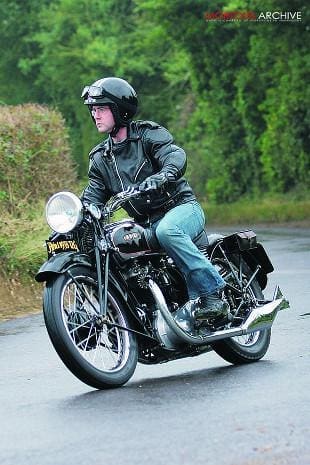 Granted, perhaps the Red Hunter didn’t have the cache of the Nortons, but it did at least have the advantage of enclosed valve gear… Other 500s with sporting pretensions included Rudge’s Ulster (£73-10s), Vincent-HRD’s Comet (£86) or possibly Excelsior’s 500cc Manxman (£75). Arguably, the Red Hunter would see off – or at least run close – the last three, and probably the CS1, and unless the Inter was properly maintained, then that too might get humbled by the Selley Oak budget thoroughbred.
Granted, perhaps the Red Hunter didn’t have the cache of the Nortons, but it did at least have the advantage of enclosed valve gear… Other 500s with sporting pretensions included Rudge’s Ulster (£73-10s), Vincent-HRD’s Comet (£86) or possibly Excelsior’s 500cc Manxman (£75). Arguably, the Red Hunter would see off – or at least run close – the last three, and probably the CS1, and unless the Inter was properly maintained, then that too might get humbled by the Selley Oak budget thoroughbred.
The NG didn’t boast such performance credentials, but it was – and is – no slouch either. Most at home on B roads, the sure-footed single proves that, by the mid- to late-30s, British manufacturers had got a good idea of what their customers wanted, and the best way they could provide it. And today, although anyone lucky enough to be in the saddle of the NG wouldn’t want to spend too much time on A roads, the Ariel proves that a 30s machine is still a reasonably practical proposition, as this fabulous example reiterates.



